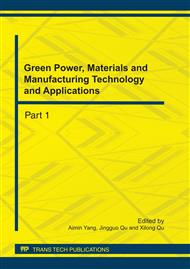p.64
p.69
p.74
p.81
p.86
p.91
p.96
p.101
p.106
Influence of Depositing Parameters on Microstructure of Ni-Co Pulse Plating
Abstract:
Influence of the pulse currents, the pulse frequency and CoSO4 content of plating solution on Co content of Ni-Co alloy coatings are investigated by environmental scanning electronic microscopy and field emission scanning electronic microscope. The result shows that Co content of Ni-Co alloy coating increases as the increase of CoSO4 content and pulse frequency. Co content of Ni-Co alloy coating increases when the current density decrease. When CoSO4 content of plating solution and the pulse frequency increase, the coating surface become smoother, microstructure become denser and coating grain refinement. when current density is small, coating crystalline grains size are tiny and the coating crystalline grains arrangement is relatively close. In the Ni-Co electrodepositing process, the combining of Ni2+ and Co2+ generates [CoNi (Ⅱ)] intermediate products, then the decomposion of [CoNi (Ⅱ)] generate Co and Ni2+. This hinders sedimentation of Ni2+ ions and increases sedimentary speed of Co2+ ion. Polarization of electrodeposited cobalt is lager than polarization of electrodeposited nickel. So as the current density increases, nickel deposition relative faster than cobalt, thus leads to the cobalt content of coating decreased. The recovering frequency of metal ion concentration in pulse spread layer rise at the fixed time as pulse frequency increases.
Info:
Periodical:
Pages:
86-90
Citation:
Online since:
August 2011
Authors:
Keywords:
Price:
Сopyright:
© 2011 Trans Tech Publications Ltd. All Rights Reserved
Share:
Citation:


